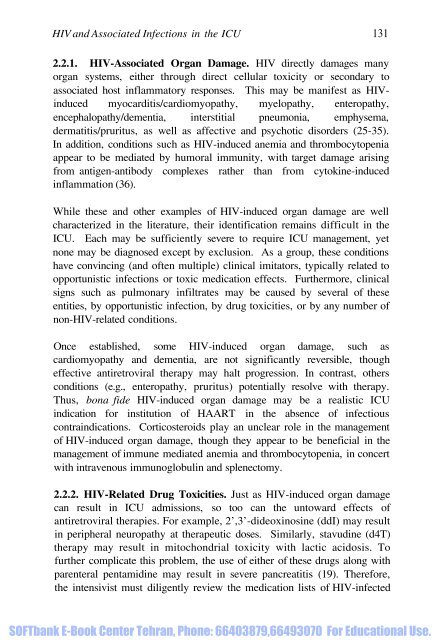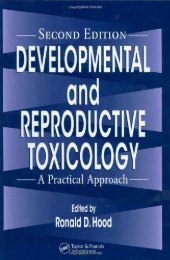SOFTbank E-Book Center Tehran, Phone: 66403879,66493070 For ...
SOFTbank E-Book Center Tehran, Phone: 66403879,66493070 For ...
SOFTbank E-Book Center Tehran, Phone: 66403879,66493070 For ...
You also want an ePaper? Increase the reach of your titles
YUMPU automatically turns print PDFs into web optimized ePapers that Google loves.
HIV and Associated Infections in the ICU 131<br />
2.2.1. HIV-Associated Organ Damage. HIV directly damages many<br />
organ systems, either through direct cellular toxicity or secondary to<br />
associated host inflammatory responses. This may be manifest as HIVinduced<br />
myocarditis/cardiomyopathy, myelopathy, enteropathy,<br />
encephalopathy/dementia, interstitial pneumonia, emphysema,<br />
dermatitis/pruritus, as well as affective and psychotic disorders (25-35).<br />
In addition, conditions such as HIV-induced anemia and thrombocytopenia<br />
appear to be mediated by humoral immunity, with target damage arising<br />
from antigen-antibody complexes rather than from cytokine-induced<br />
inflammation (36).<br />
While these and other examples of HIV-induced organ damage are well<br />
characterized in the literature, their identification remains difficult in the<br />
ICU. Each may be sufficiently severe to require ICU management, yet<br />
none may be diagnosed except by exclusion. As a group, these conditions<br />
have convincing (and often multiple) clinical imitators, typically related to<br />
opportunistic infections or toxic medication effects. Furthermore, clinical<br />
signs such as pulmonary infiltrates may be caused by several of these<br />
entities, by opportunistic infection, by drug toxicities, or by any number of<br />
non-HIV-related conditions.<br />
Once established, some HIV-induced organ damage, such as<br />
cardiomyopathy and dementia, are not significantly reversible, though<br />
effective antiretroviral therapy may halt progression. In contrast, others<br />
conditions (e.g., enteropathy, pruritus) potentially resolve with therapy.<br />
Thus, bona fide HIV-induced organ damage may be a realistic ICU<br />
indication for institution of HAART in the absence of infectious<br />
contraindications. Corticosteroids play an unclear role in the management<br />
of HIV-induced organ damage, though they appear to be beneficial in the<br />
management of immune mediated anemia and thrombocytopenia, in concert<br />
with intravenous immunoglobulin and splenectomy.<br />
2.2.2. HIV-Related Drug Toxicities. Just as HIV-induced organ damage<br />
can result in ICU admissions, so too can the untoward effects of<br />
antiretroviral therapies. <strong>For</strong> example, 2’,3’-dideoxinosine (ddI) may result<br />
in peripheral neuropathy at therapeutic doses. Similarly, stavudine (d4T)<br />
therapy may result in mitochondrial toxicity with lactic acidosis. To<br />
further complicate this problem, the use of either of these drugs along with<br />
parenteral pentamidine may result in severe pancreatitis (19). Therefore,<br />
the intensivist must diligently review the medication lists of HIV-infected<br />
<strong>SOFTbank</strong> E-<strong>Book</strong> <strong>Center</strong> <strong>Tehran</strong>, <strong>Phone</strong>: <strong>66403879</strong>,<strong>66493070</strong> <strong>For</strong> Educational Use.





